桂林理工大学固体物理考博真题试题2014—2019年
- 格式:pdf
- 大小:1.72 MB
- 文档页数:6
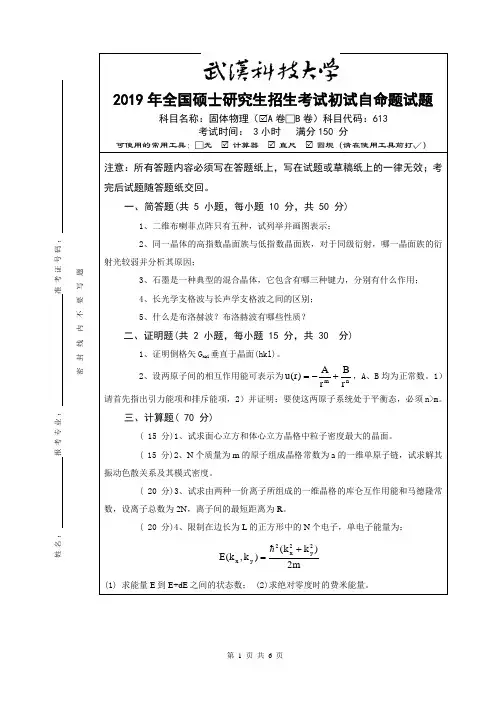
姓名:报考专业: 准考证号码:密封线内不要写题2019年全国硕士研究生招生考试初试自命题试题科目名称:固体物理( A 卷□B 卷)科目代码:613考试时间: 3小时 满分150 分可使用的常用工具:□无 计算器 直尺 圆规(请在使用工具前打√)注意:所有答题内容必须写在答题纸上,写在试题或草稿纸上的一律无效;考完后试题随答题纸交回。
一、简答题(共 5 小题,每小题 10 分,共 50 分)1、二维布喇菲点阵只有五种,试列举并画图表示;2、同一晶体的高指数晶面族与低指数晶面族,对于同级衍射,哪一晶面族的衍射光较弱并分析其原因;3、石墨是一种典型的混合晶体,它包含有哪三种键力,分别有什么作用;4、长光学支格波与长声学支格波之间的区别;5、什么是布洛赫波?布洛赫波有哪些性质?二、证明题(共 2 小题,每小题 15 分,共 30 分)1、证明倒格矢G hkl 垂直于晶面(hkl)。
2、设两原子间的相互作用能可表示为n m rBr A )r (u +-=,A 、B 均为正常数。
1)请首先指出引力能项和排斥能项,2)并证明:要使这两原子系统处于平衡态,必须n>m 。
三、计算题( 70 分)( 15 分)1、试求面心立方和体心立方晶格中粒子密度最大的晶面。
( 15 分)2、N 个质量为m 的原子组成晶格常数为a 的一维单原子链,试求解其振动色散关系及其模式密度。
( 20 分)3、试求由两种一价离子所组成的一维晶格的库仑互作用能和马德隆常数,设离子总数为2N ,离子间的最短距离为R 。
( 20 分)4、限制在边长为L 的正方形中的N 个电子,单电子能量为:m2)k k ()k ,k (E 2y 2x 2y x +=(1) 求能量E 到E+dE 之间的状态数; (2)求绝对零度时的费米能量。
姓名:报考专业: 准考证号码:密封线内不要写题2019年全国硕士研究生招生考试初试自命题试题科目名称:固体物理( A 卷□B 卷)科目代码:613考试时间: 小时 满分 分可使用的常用工具: 无 □计算器 □直尺 □圆规(请在使用工具前打√)注意:所有答题内容必须写在答题纸上,写在试题或草稿纸上的一律无效;考完后试题随答题纸交回。
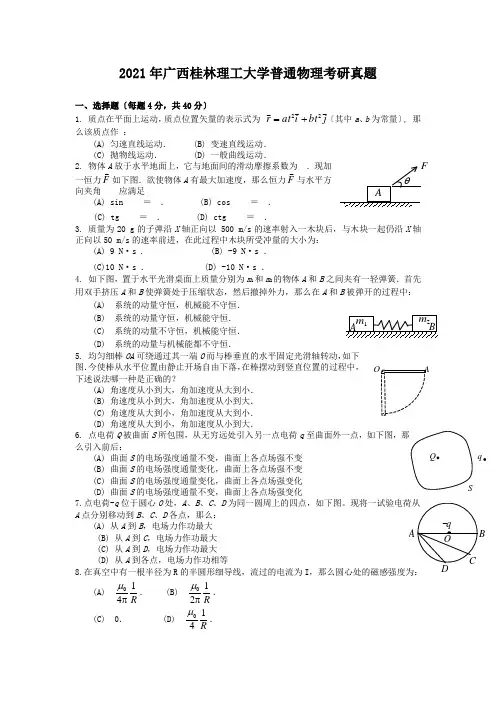
A B CO-qQ Sq 2021年广西桂林理工大学普通物理考研真题一、选择题〔每题4分,共40分〕1. 质点在平面上运动,质点位置矢量的表示式为 j bt i at r 22+=〔其中a 、b 为常量〕, 那么该质点作 : (A) 匀速直线运动. (B) 变速直线运动.(C) 抛物线运动. (D) 一般曲线运动.2. 物体A 放于水平地面上,它与地面间的滑动摩擦系数为.现加一恒力F 如下图.欲使物体A 有最大加速度,那么恒力F与水平方向夹角应满足 (A) sin =. (B) cos=.(C) tg =. (D) ctg =.3. 质量为20 g 的子弹沿X 轴正向以 500 m/s 的速率射入一木块后,与木块一起仍沿X 轴正向以50 m/s 的速率前进,在此过程中木块所受冲量的大小为: (A) 9 N ·s . (B) -9 N ·s .(C)10 N ·s . (D) -10 N ·s .4. 如下图,置于水平光滑桌面上质量分别为m 1和m 2的物体A 和B 之间夹有一轻弹簧.首先用双手挤压A 和B 使弹簧处于压缩状态,然后撤掉外力,那么在A 和B 被弹开的过程中: (A) 系统的动量守恒,机械能不守恒. (B) 系统的动量守恒,机械能守恒. (C) 系统的动量不守恒,机械能守恒.(D) 系统的动量与机械能都不守恒.5. 均匀细棒OA 可绕通过其一端O 而与棒垂直的水平固定光滑轴转动,如下图.今使棒从水平位置由静止开场自由下落,在棒摆动到竖直位置的过程中,下述说法哪一种是正确的? (A) 角速度从小到大,角加速度从大到小. (B) 角速度从小到大,角加速度从小到大.(C) 角速度从大到小,角加速度从大到小.(D) 角速度从大到小,角加速度从小到大.6. 点电荷Q 被曲面S 所包围,从无穷远处引入另一点电荷q 至曲面外一点,如下图,那么引入前后:(A) 曲面S 的电场强度通量不变,曲面上各点场强不变(B) 曲面S 的电场强度通量变化,曲面上各点场强不变 (C) 曲面S 的电场强度通量变化,曲面上各点场强变化(D) 曲面S 的电场强度通量不变,曲面上各点场强变化7.点电荷-q 位于圆心O 处,A 、B 、C 、D 为同一圆周上的四点,如下图。
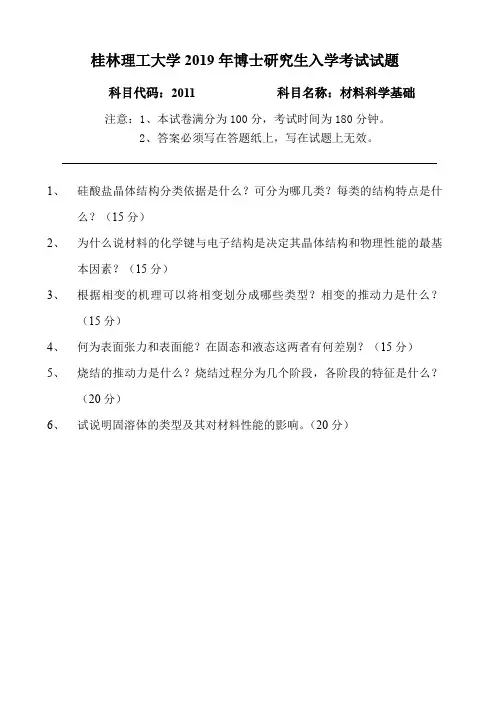
桂林理工大学2019年博士研究生入学考试试题
科目代码:2011 科目名称:材料科学基础
注意:1、本试卷满分为100分,考试时间为180分钟。
2、答案必须写在答题纸上,写在试题上无效。
1、硅酸盐晶体结构分类依据是什么?可分为哪几类?每类的结构特点是什
么?(15分)
2、为什么说材料的化学键与电子结构是决定其晶体结构和物理性能的最基
本因素?(15分)
3、根据相变的机理可以将相变划分成哪些类型?相变的推动力是什么?
(15分)
4、何为表面张力和表面能?在固态和液态这两者有何差别?(15分)
5、烧结的推动力是什么?烧结过程分为几个阶段,各阶段的特征是什么?
(20分)
6、试说明固溶体的类型及其对材料性能的影响。
(20分)。
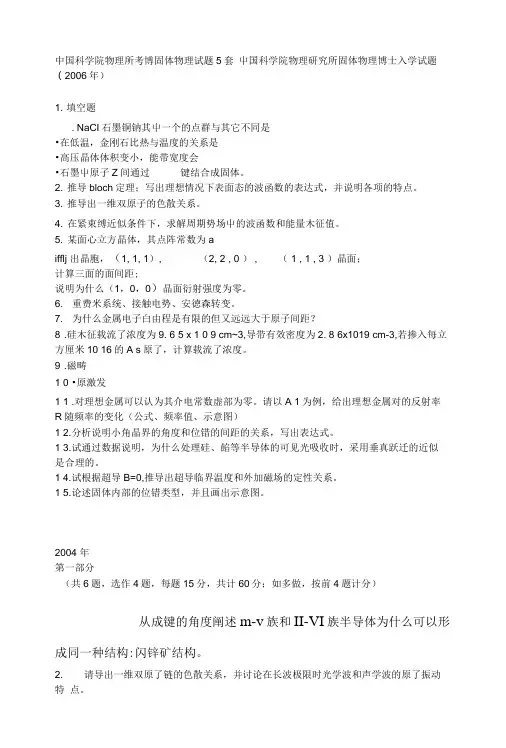
中国科学院物理所考博固体物理试题5套屮国科学院物理研究所固体物理博士入学试题(2006年)1. 填空题.NaCI石墨铜钠其屮一个的点群与其它不同是•在低温,金刚石比热与温度的关系是•高压晶体体积变小,能带宽度会•石墨屮原子Z间通过键结合成固体。
2. 推导bloch定理;写出理想情况下表面态的波函数的表达式,并说明各项的特点。
3. 推导出一维双原子的色散关系。
4. 在紧束缚近似条件下,求解周期势场屮的波函数和能量木征值。
5. 某面心立方晶体,其点阵常数为aifflj 出晶胞,(1, 1, 1), (2, 2 , 0 ) , ( 1 , 1 , 3 )晶面;计算三面的面间距;说明为什么(1,0,0)晶面衍射强度为零。
6. 重费米系统、接触电势、安徳森转变。
7. 为什么金属电子白由程是有限的但又远远大于原子间距?8 .硅木征载流了浓度为9. 6 5 x 1 0 9 cm~3,导带有效密度为2. 8 6x1019 cm-3,若掺入每立方厘米10 16的A s原了,计算载流了浓度。
9 .磁畴1 0 •原激发1 1 .对理想金属可以认为其介电常数虚部为零。
请以A 1为例,给出理想金属对的反射率R随频率的变化(公式、频率值、示意图)1 2.分析说明小角晶界的角度和位错的间距的关系,写出表达式。
1 3.试通过数据说明,为什么处理硅、餡等半导体的可见光吸收时,采用垂真跃迁的近似是合理的。
1 4.试根据超导B=0,推导出超导临界温度和外加磁场的定性关系。
1 5.论述固体内部的位错类型,并且画出示意图。
2004 年第一部分(共6题,选作4题,每题15分,共计60分;如多做,按前4题计分)从成键的角度阐述m-v族和II-VI族半导体为什么可以形成同一种结构:闪锌矿结构。
2. 请导出一维双原了链的色散关系,并讨论在长波极限时光学波和声学波的原了振动特点。
3. 从声子的概念出发,推导并解释为什么在一般晶体屮的低温品格热容量和热导率满足T3关系。

桂林理工大学期末考试2013-2014级《晶体光学》(考试时间90分钟,满分100分)一、判断题(打√或╳;每题1分,共10分)1.光率体椭圆短半径方向为快光,长半径方向为慢光。
( )2.一轴晶光率体Ne为光轴,二轴晶光率体Ng为光轴。
( )3.二轴晶垂直Bxa切面的双折率一定大于垂直Bxo切面的双折率。
( )4.黑云母解理缝平行十字丝纵丝时,所见的浅黄色是N p的颜色。
( )5.正交偏光间出现全消光现象的颗粒一定是均质体。
( )6.某岩石薄片中,具有不同干涉色的颗粒,一定不是同一种矿物。
( )7.某矿片干涉色加云母试板后,一个45°位变为红,另一个45°位变为绿,那么原来干涉色一定是蓝。
( )8.某矿片干涉色加石膏试板后,一个45°位变为黄,另一个45°位变为灰,那么原来干涉色一定是一级黄( )9.一轴晶干涉图当视域内见一条横臂,顺时针转物台,其向下平行移动,说明黑十字中心在视域右侧。
( )10.二轴晶垂直Bxa切面干涉图中,两个弯曲黑带顶点连线方向为Bxa投影方向。
( )二、选择题(单选字母;每题1分,共10分)1.黑云母解理缝平行十字丝横丝时呈深棕色,该颜色是光率体椭圆半径()的颜色。
A、N g,B、N m,C、N p,D、N g或N m2.某矿物为正中突起,其折射率范围为( )。
A、1.54~1.60,B、1.60~1.66,C、1.66~1.783.干涉色色谱表中,Ⅱ级绿对应的光程差范围大致为( )。
A、550~700nm,B、700~800nm,C、800~950nm ,D、950~1100nm4.某矿片干涉色为Ⅱ级蓝,若薄片为标准厚度,那么该矿片的双折率范围是( )。
A、0.018~0.023,B、0.023~0.027,C、0.027~0.032,D、0.032~0.037 5.某矿片干涉色为灰,加石膏试板后干涉色变为蓝,那么两光率体椭圆是( )。
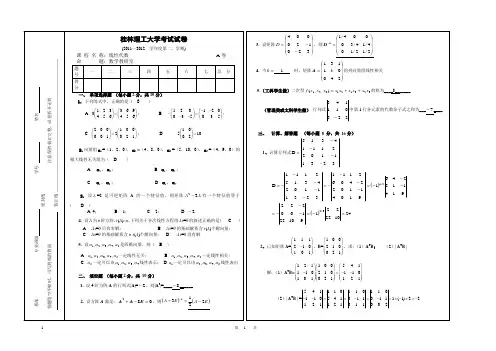
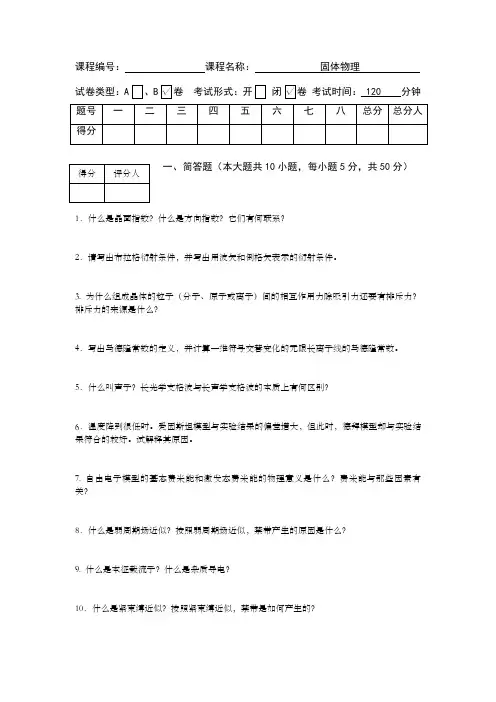
课程编号: 课程名称: 固体物理试卷类型:卷 考试形式:开 考试时间: 120 分钟 一、简答题(本大题共10小题,每小题5分,共50分)1.什么是晶面指数?什么是方向指数?它们有何联系?2.请写出布拉格衍射条件,并写出用波矢和倒格矢表示的衍射条件。
3. 为什么组成晶体的粒子(分子、原子或离子)间的相互作用力除吸引力还要有排斥力?排斥力的来源是什么?4.写出马德隆常数的定义,并计算一维符号交替变化的无限长离子线的马德隆常数。
5.什么叫声子?长光学支格波与长声学支格波的本质上有何区别?6.温度降到很低时。
爱因斯坦模型与实验结果的偏差增大,但此时,德拜模型却与实验结果符合的较好。
试解释其原因。
7. 自由电子模型的基态费米能和激发态费米能的物理意义是什么?费米能与那些因素有关?8.什么是弱周期场近似?按照弱周期场近似,禁带产生的原因是什么?9. 什么是本征载流子?什么是杂质导电?10.什么是紧束缚近似?按照紧束缚近似,禁带是如何产生的?二、计算题(本大题共5小题,每小题10分,共50分)1. 考虑一在球形区域内密度均匀的自由电子气体,电子系统相对于等量均匀正电荷背景有一小的整体位移,证明在这一位移下系统是稳定的,并给出这一小振动问题的特征频率。
2. 如将布拉维格子的格点位置在直角坐标系中用一组数),,(321n n n 表示,证明:对于面心立方格子,i n 的和为偶数。
3. 设一非简并半导体有抛物线型的导带极小,有效质量m m 1.0=*,当导带电子具有k T 300=的平均速度时,计算其能量、动量、波矢和德布罗意波长。
4. 对于原子间距为a ,由N 个原子组成的一维单原子链,在德拜近似下, (1)计算晶格振动频谱;(2)证明低温极限下,比热正比于温度T 。
5. 对原子间距为a 的由同种原子构成的二维密堆积结构, (1)画出前三个布里渊区;(2)求出每原子有一个自由电子时的费米波矢; (3)给出第一布里渊区内接圆的半径;(4)求出内接圆为费米圆时每原子的平均自由电子数;(5)平均每原子有两个自由电子时,在简约布里渊区中画出费米圆的图形。
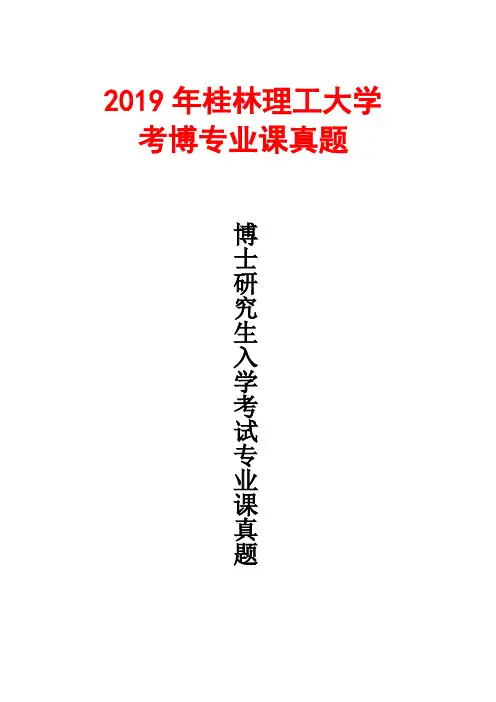
博士研究生入学考试专业课真题 2019年桂林理工大学考博专业课真题
桂林理工大学2019年博士研究生入学考试试题
科目代码:3013 科目名称:结晶学
注意:1、本试卷满分为100分,考试时间为180分钟。
2、答案必须写在答题纸上,写在试题上无效。
1、解释对称的概念,简要说明存在哪几种宏观对称要素。
(15分)
2、在晶体形核生长过程当中涉及哪两种能量变化?只有满足何种条件的晶
核才能稳定长大?(15分)
3、等大球最紧密堆积有哪两种基本形式?存在哪两种空隙?(15分)
4、什么是配位数?常见的配位数数值有哪些?(15分)
5、简要说明晶体生长的两种主要生长理论模型。
(20分)
6、晶体的极射赤平投影的目的是什么?请将左图的所有晶面投影到极射赤
平投影圆中。
(20分)。
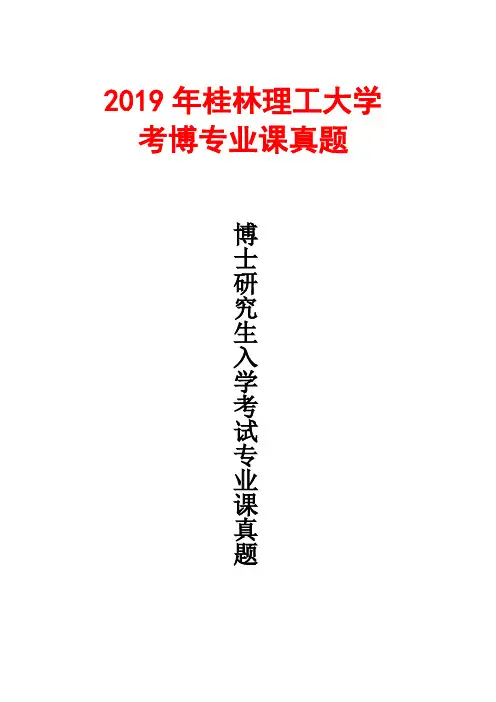
博士研究生入学考试专业课真题 2019年桂林理工大学考博专业课真题2019考试科目代码:1001考试科目名称:英语Part I Reading Comprehension (45%)Directions: There are 3 passages in this part. Each passage is followed by some questions or unfinished statements.For each of them there are four choices marked A), B), C) and D). You should decide on the best choice.Passage OneQuestions 1 to 5 are based on the following passage.Less than two months into her breast cancer treatment, Alexandra Jn-Charles was called into a new room at SUNY Downstate Medical Center, where two treating physicians, the chief medical officer and an attorney representing the hospital told her that mistakes had been made.The skin lesions (病变) on her chest, they said, had been caused not by her illness but by the machine that was supposed to cure her. The 32-year-old had received nearly 30 radiotherapy sessions, but at this point it didn’t really make sense to count them, because a programming error had caused each installment to deliver at least three times the prescribed amount of radiation.Jn-Charles, who died two and a half years after this meeting in 2005, would eventually come to exemplify the emergence of accidental over-radiation in U.S. hospitals. The worst off have reported skin damage, inexplicable hair loss and ribs(肋骨) buckling beneath their chests — debilitating injuries suffered while undergoing screening or treatment for something that would otherwise kill them. A steep price for survival.These tragedies go to the core of an issue as pressing as it is uncomfortable to think about: Have advances in technology, improved treatment methods and more comprehensive screening protocols led to systematic, excessive irradiation of patients?The answer, according to a growing number of health experts, is yes. For example, the CT scan, which has become commonplace in response to rising cancer rates, is itself thought to increase the likelihood that a person develops cancer. The scans deliver several hundred times more radiation than an X-ray — even when guidelines and dosages are followed precisely. “What we do as physicians arguably harms people,” James Ehrlich, a clinical associate professor at the University of Colorado and an adviser for Premier Micronutrient Corp., told Newsweek.A jarring example of that came in 2010, when Walt Bogdanich published an extensive review in The New York Times that listed numerous patients whose lives had been destroyed by mistakes in hospital imaging and radiotherapy. Shortly after the article series went to press, the Food and Drug Administration began to ramp up its efforts to limit excessive exposure, eventually launching its Initiative to Reduce Unnecessary Radiation Exposure From Medical Imaging.Along with organizations like the American College of Radiology, the FDA now supports a number of so-called dose registries that allow facilities to compare radiation dose indexes to regional and national values. To date, hundreds of facilities across the U.S. have enrolled.But the FDA’s regulatory authority is generally focused on equipment manufacturers, and compliance on the state level is never guaranteed. And even compliant facilities run the risk of over-radiating patients: A 2012 paper bythe Institute of Medicine found that medical imaging is one of the leading environmental causes of breast cancer.1. The skin damage on Jn-Charles’ chest was caused by ______.A) breast cancerB) advanced technologyC) over-radiationD) treatment methods1. What does the author want to explain by exemplifying Jn-Charles?A) There is no need to waste so much money for to treat breast cancer.B) Until now, breast cancer is still an incurable illness around the world.C) There is an increasing number of young people suffering from cancer.D) There are incidents of excessive irradiation of patients in America.3. What can be learnt about the CT scan?A) It is a double-edged sword in the term of cancer.B) It has been argued in the medical profession.C) It is much safer to be used to treat breast cancer.D) The radiation dosages can be controlled easily.4. What does the word “ramp up” (Para. 6) mean?A) Heat up.B) Draw out.C) Intensify.D) Put up.5. The author thinks FDA’s solution to reduce radiation exposure is ______.A) ineffectiveB) looseC) harmfulD) unnecessaryPassage TwoQuestions 6 to 10 are based on the following passage.Like a tired marriage, the relationship between libraries and publishers has long been reassuringly dull. E-books, however, are causing heartache. Libraries know they need digital wares if they are to remain relevant, but many publishers are too wary of piracy and lost sales to co-operate. Among the big six, only Random House and HarperCollins license e-books with most libraries. The others have either denied requests or are reluctantly experimenting. In August, for example, Penguin will start a pilot with public libraries in New York.Publishers are wise to be nervous. Owners of e-readers are exactly the customers they need: book-lovers with money (neither the devices nor broadband connections come cheap). If these wonderful people switch to borrowing e-books instead of buying them, what then?Electronic borrowing is awfully convenient. Unlike printed books, which must be checked out and returned to a physical library miles from where you live, book files can be downloaded at home. Digital library catalogues are often browsed at night, from a comfy sofa. The files disappear from the device when they are due (which means no late fees, nor worry about lost or damaged books).Awkwardly for publishers, buying an e-book costs more than renting one but offers little extra value. You cannot resell it, lend it to a friend or burn it to stay warm. Owning a book is useful if you want to savour(品尝)it repeatedly, but who reads “Fifty Shades of Grey” twice?E-lending is not simple, however. There are lots of different and often incompatible e-book formats, devices and licences. Most libraries use a company called OverDrive, a global distributor that secures rights from publishers and provides e-books and audio files in every format. Some 35m titles were checked out through OverDrive in 2011, and the company now sends useful data on borrowing behaviour to participating publishers. Yet publishers and libraries are worried by OverDrive’s market dominance, as the company can increasingly dictate fees and conditions.Library boosters argue that book borrowers are also book buyers, and that libraries are vital spaces for readers to discover new work. Many were cheered by a recent Pew survey, which found that more than half of Americans with library cards say they prefer to buy their e-books. But the report also noted that few people know that e-books are available at most libraries, and that popular titles often involve long waiting lists, which may be what inspires people to buy.So publishers keep tweaking(对……稍作调整)their lending arrangements in search of the right balance. Random House raised its licensing prices earlier this year, and HarperCollins limits libraries to lending its titles 26 times. Penguin plans to keep new releases out of libraries for at least six months, and each book will expire after a year. The story of the library e-book is a nail-biter.6. What can we learn about the big six publishers?A) They know they need to cooperate with libraries.B) They have recently sold e-books to most libraries.C) Most of them hesitate in cooperation with libraries.D) They stand out against selling e-books to libraries.7. What is the advantage of electronic borrowing?A) There is no need to worry about deadlines.B) It can pay for the late fees automatically.C) Readers can lend the book files to their friends.D) It is much cheaper than traditional printed books.8. Why are publishers and libraries worried about OverDrive’s market dominance?A) Publisher and libraries will lose their market shares of e-books.B) OverDrive provides various format of e-books and audio files.C) OverDrive will increasingly divide their profit of e-books.D) E-readers will not lend e-books or audio files from libraries.9. What was shown in Pew survey?A) The desire to collect popular books inspires people to buy them.B) E-readers in America prefer to buy their e-books from libraries.C) More than half of Americans are book borrowers and book buyers.D) People with library cards usually have to wait for popular e-books.10. What does the author mean by saying “The story of the library e-book is a nail-biter.” (Para. 7)?A) Many problems about e-book lending need to be solved.B) It is wise for publishers to cooperate closely with libraries.C) Cooperation between publishers and libraries is a win-win strategy.D) Libraries will dominant the book market by lending e-books.Passage ThreeQuestions 11 to 15 are based on the following passage.Across the board, American colleges and universities are not doing a very good job of preparing their students for the workplace or their post-graduation lives. This was made clear by the work of two sociologists, Richard Arumand Josipa Roksa. In 2011 they released a landmark study titled “Academically Adrift,” which documented the lack of intellectual growth experienced by many people enrolled in college. In particular, Arum and Roksa found, college students were not developing the critical thinking, analytic reasoning and other higher-level skills that are necessary to thrive in today’s knowledge-based economy and to lead our nation in a time of complex challenges and dynamic change.Arum and Roksa placed the blame for students’ lack of learning on a watered-down college curriculum and lowered undergraduate work standards. Although going to college is supposed to be a full-time job, stu- dents spent, on average, only 12 to 14 hours a week studying and many were skating through their semesters without doing a significant amount of reading and writing. Students who take more challenging classes and spend more time studying do learn more. But the priorities of many undergraduates are with extracurricular activities, playing sports, and partying and socializing.Laura Hamilton, the author of a study on parents who pay for college, will argue in a forthcoming book that college administrations are overly concerned with the social and athletic activities of their students. In Paying for the Party, Hamilton describes what she calls the “party pathway,” which eases many students through college, helped along by various clubs that send students into the party scene and a host of easier majors. By sanctioning this watered-down version of college, universities are “catering to the social and educat ional needs of wealthy students at the expense of others” who won’t enjoy the financial backing or social connections of richer students once they graduate.These students need to build skills and knowledge during college if they are to use their degrees as a stepping-stone to middle-class mobility. But more privileged students must not waste this opportunity either. As recent graduates can testify, the job market isn’t kind to candidates who can’t demonstrate genuine competence, along with a well-cultivated willingness to work hard. Nor is the global economy forgiving of an American workforce with increasingly weak literacy, math and science abilities. College graduates will still fare better than those with only a high school education, of course. But a university degree unaccompanied by a gain in knowledge or skills is an empty achievement indeed. For students who have been coasting through college, and for American universities that have been demanding less work, offering more attractions and charging higher tuition, the party may soon be over.11. What is Arum and Roksa’s finding about higher education in America?A) It aims at stimulating the intellectual curiosity of college students.B) It fails to prepare students to face the challenges of modern times.C) It has experienced dramatic changes in recent years.D) It has tried hard to satisfy students’ various needs.12. What is responsible for the students’ lack of higher-level skills?A) The diluted college curriculum.B) The boring classroom activities.C) The absence of rigorous discipline.D) The outdated educational approach.13. What does Laura Hamilton say about college administrations?A) They fail to give adequate help to the needy students.B) They tend to offer too many less challenging courses.C) They seem to be out of touch with society.D) They prioritize non-academic activities.14. What can be learned about the socially and financially privileged students?A) They tend to have a sense of superiority over their peers.B) They can afford to choose easier majors in order to enjoy themselves.C) They spend a lot of time building strong connections with businesses.D) They can climb the social ladder even without a degree.15. What does the author suggest in the last paragraph?A) American higher education has lost its global competitiveness.B) People should not expect too much from American higher education.C) The current situation in American higher education may not last long.D) It will take a long time to change the current trend in higher education.Part II Translation (25%)Directions: For this part, you are to translate a passage from Chinese into English.西安是我国黄河流域古代文明的重要发源地之一,与雅典、罗马、开罗并称为世界四大古都。